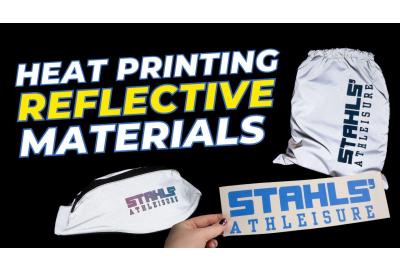How To Heat Print Reflective Materials
How to Heat Print Reflective Materials
The purpose of reflective clothing is to signal the presence of the user in potentially hazardous situations or locations. High-visibility clothing is an important aspect of PPE in many industries. Because reflective attire is so commonly used across the world, the global industry was recently valued at $1.6 billion.
Some occupations that require high-visibility workwear include:
- Construction workers & road construction workers
- Rail workers
- Heavy equipment operators
- Engineering & utility workers
- Emergency responders
- Crossing & parking attendants
- Airport ground crews
- Road sweepers
- Event security
- Waste management workers
But users of reflective clothing don't just stop at workwear!
Reflective materials are heavily used in sports and hobbies too. You can commonly find reflective materials within bags, accessories and jackets too.
Cyclists and runners commonly use reflective bags or jackets in order to make their presence on the road known. In 2022, approximately 7.61 million people participated in cycling, either for sport, leisure or travel, in England.
So, how can you incorporate reflective materials into your heat-printed offering?
Bags
BagBase currently offer 3 reflective bag options with endless audience opportunities
The BG137 is a drawstring gym-style bag that could be easily marketed to cyclists, school children (and their parents), and generally anyone who might walk outside at night.
The BG134 is a fanny pack waist bag (also known as a bum bag). Functional and lightweight, this option would be popular among climbers, runners, joggers or even festival and gig goers who need their hands and arms free at all times.
The BG138 is a large backpack and can be used by walkers and travellers to carry a large amount of personal belongings.
UltraColour Heat Transfers
Due to reflective materials being made of polyester, they are extremely heat-sensitive and often difficult to decorate. This can be enough to put any heat printer off including them in their product range.
But do not fear, there's is absolutely no reason to be scared of heat printing polyester when you're using UltraColour Heat Transfers.
UltraColour heat transfers fuse at just 120° celcius making them the lowest fusing heat transfers on the market. This also means that they will fuse onto heat-sensitive materials like polyester and acrylic without leaving any scorch marks!
While we would always recommend testing your products yourself to see what works for your heat press and blank garments, the basic equation is here. If the material is heat sensitive, give it less heat.
Some reflective blanks may find success with UltraColour Max heat transfers that fuse at 145° but it goes without saying that Screen Printed heat transfers that fuse at 160° or most Heat Transfer Vinyl options are out of the equation unless you want a melted or scorched product.




